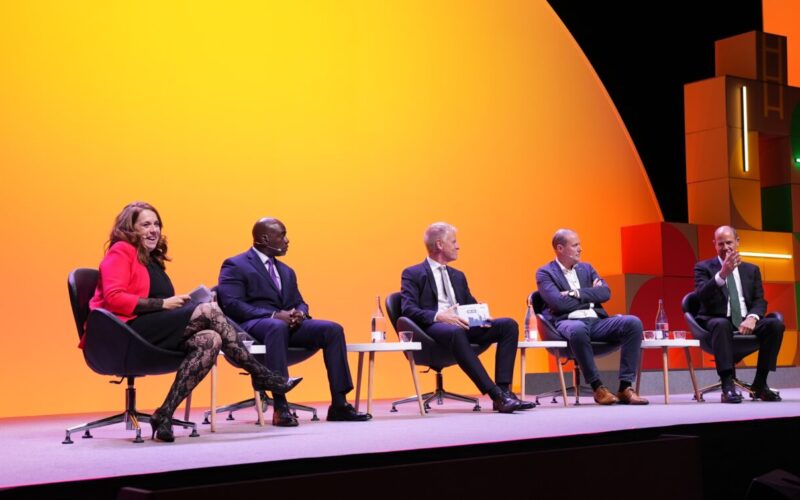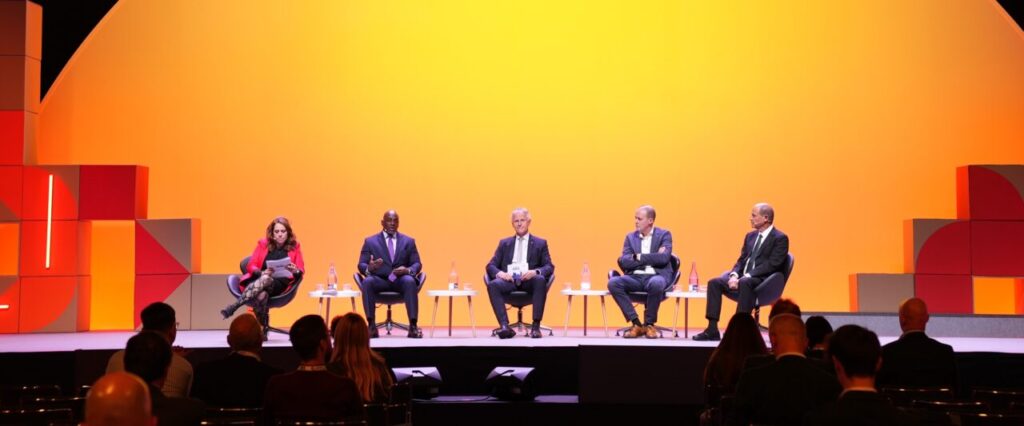PTI was honoured to attend the welcoming session of Smart Ports: Piers of the Future on 7 November 2023, a remarkable roundtable discussion that gathered high-ranking executives from leading ports worldwide. The Panel Session was moderated by Emma Cobos, Director of Innovation and Business Strategy at the Port of Barcelona. The Port of Barcelona has played an essential role in promoting the blue economy in Barcelona, standing out for significant initiatives such as the BlueTechPort. Serving as a pioneering business hub, the port acts as a driving force for companies, aiming to foster innovation across all sectors associated with the Blue Economy.
During the panel, participants delved into the domains of digitalisation, sustainability, and collaborative initiatives, underscoring how innovation holds the potential to fuel growth, sustainability, and prosperity for both port operations and urban areas.
READ: Smart Ports: Piers of the Future 2023. What to expect
Connecting ports and cities: Driving sustainability and innovation in port development
The panel kicked off with a question on sustainability and innovation within the port industry, shedding light on the strategies and collaborative efforts underway to shape the future of ports.
Jens Meier, Chief Executive Officer, Port of Hamburg, emphasized the port’s shift towards a broader innovation strategy that extends beyond container business, embracing digitalisation and working in tandem with the city. The port’s approach includes the development of a master plan with a strategic vision and operational implementation as key components, covering aspects like digitisation, automation, climate action, and infrastructure development with IT systems.
READ: Ports of Hamburg, Halifax, Valencia create port innovation hub network
Erwin Verstraelen, Chief Digital & Innovation Officer, Port of Antwerp-Bruges, highlighted the synergy between the city and the port, emphasizing the need to influence each other’s work positively. Antwerp is evolving into an innovation district, with a dedication to a circular economy and establish complementary innovation hubs. Its Beacon ecosystem is likely to drive forward the concept of digitalisation as it focuses on research around Internet of Things (IoT).
Michael DiBernardo, Deputy Executive Director Marketing and Customer Relations, Port of Los Angeles, discussed their collaboration with the state of California to create a master plan for decarbonisation. Being a crucial gateway for nearly 40 per cent of the nation’s goods, they focus on diversification and sustainability, aiming to create jobs while maintaining a commitment to sustainable practices.
John Roberson, Chief Operating Officer, City of Chicago, discussed the intersection of innovation and infrastructure. He stressed the importance of reimagining critical assets to ensure they remain economic drivers and assets that drive job creation while contributing to environmental justice. The Port of Chicago, situated in a historically neglected area at the heart of the steel industry, aims to improve infrastructure around the port to demonstrate its potential for resiliency and sustainability, ultimately enhancing the quality of life for local residents.
Energy transition and digitalisation projects in the spotlight
Next, the panellists shared insights into various aspects of sustainability and innovation within the port industry.
The Port of Antwerp-Bruges stressed the importance of digital transformation, highlighting that it inherently contributes to sustainability by increasing transparency and reducing fragmentation. He discussed the evolution of Antwerp, pointing out the need to maintain capacity while minimising ecological impact, particularly in the context of an inland port and the use of Port Community Systems (PCS).
READ: APICA: The Digital Twin Solution Transforming the Port of Antwerp-Bruges
Roberson talked about the port’s Smart Grid Project and efficient infrastructure, aiming to conserve energy while benefitting the local community in Chicago. He pointed out the need to invest in sustainability with a focus on the infrastructure surrounding the ports, which often intersect with neighbourhoods.
The Port of LA highlighted the environmental responsibility aspect, citing the Clean Air Action Plan aimed at reducing ship emissions. The plan includes targets like replacing yard equipment with zero-emission alternatives by 2030 and requiring all trucks to be zero-emission by 2035. Collaborative efforts with various countries and partners, as well as the use of shore power for ships in close proximity to communities, underscore the port’s commitment to reducing emissions.
READ: Ports of Los Angeles, Long Beach and Shanghai outline green shipping corridor plan
Meier discussed Hamburg’s role as a driver for sustainability and innovation, emphasizing the role of ports in the energy transition. Ports are becoming centres for energy generation and innovation, essential for importing wind power and promoting cooperation among ports. Hydrogen is seen as a mean to green up other industries, positioning ports as hubs for alternative energy import and export. This shift reflects a changing perspective where ports are seen as energy generation spaces, requiring a different approach from the past, including the hiring of energy transition experts, which was unthinkable a decade ago.
Navigating the future: Ports as pioneers in the Blue Economy
The panel discussion covered various strategies and initiatives related to sustainability and innovation within the port industry.
Meier emphasized the need for a forward-looking vision, envisioning a future where the noise of seagulls exceeds that of vessels – as he vividly pointed out – underlining the importance of noise reduction in urban ports. He also stressed the significance of structured ports and more efficient logistics to reduce emissions and unnecessary transportation, thereby decarbonising the surrounding areas. Ports, he argued, should be innovation hubs, testing grounds for solutions that can later be applied in cities.
Verstraelen discussed Antwerp’s approach to climate impact mitigation, including measures to clean up historical pollution and employing drones for oil spill detection. Their vision for a blue economy involves shifting transportation from roads to barges, with remote-piloted vessels monitored by a single pilot, and the development of remote-piloted drones to enhance efficiency. Antwerp also intends to use remote pilot drones beyond the visible line of sight to facilitate efficient port and terminal operations, with federal approval.
DiBernardo brought attention to Microsoft’s data centre for water, designed to enhance water circulation and reduce emissions. He also mentioned strategies to optimise container terminals, reduce waiting times, and support the blue economy through solar energy adoption.
READ: San Pedro Bay ports complex awarded $1.2 billion federal hydrogen grant
Roberson explained Chicago’s efforts to pilot tech solutions for ports and invest in economic development along the riverfront. Their focus includes reducing road traffic by increasing the use of barges for cargo transportation, necessitating significant innovative investment and meaningful discussion with manufacturers.
Biggest challenges over the next decade
As the panel drew to a close, speakers delved into the distinct challenges that lie ahead for ports in the coming decade within the broader context of emission reduction and the pursuit of sustainability.
DiBernardo stressed the critical significance of reducing emissions, with a particular focus on addressing the often-overlooked last-mile emissions, which play a pivotal role in advancing the sustainability agenda.
Verstraelen voiced his unwavering commitment to catalysing a sustainable future, shedding light on the intricate challenges faced in securing permits across Europe.
READ: Port of Antwerp-Bruges acquires six new tugs
The Port of Hamburg Authority contemplated the delicate balance required to modernise infrastructure at the port, which boasts a rich history of over 800 years. His vision extends to incorporating cutting-edge technology and innovation, all while carefully navigating the fine line between reconstruction and future-focused investment.
To conclude the panel, Roberson underlined the importance of investments in ports that extend beyond vessel handling and job creation, taking into account the broader impact on the surrounding neighbourhoods in Chicago. His vision emphasizes the alignment of port growth with the well-being of the local community.










